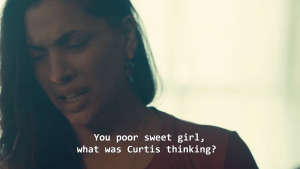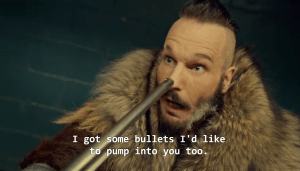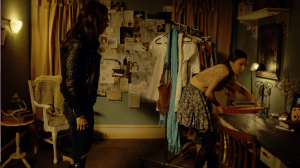This post I’d like to focus in on the color choices the show uses. Wynonna Earp primarily uses two colors for lighting: blue and yellow. Contrary to my previous reviews, Wynonna Earp actually makes successful use of these lighting choices, even if they are rudimentary. The different lighting makes the scenes feel different and adds a slight accent so the show does not constantly look the same. In addition, the two colors do not have a constant meaning, which I think is good. Instead, each scene is colored in a way that complements the scene. In addition to lighting, Wynonna Earp frequently uses to color as symbolism.
In Episode 10 we can see examples of Wynonna Earp successfully using color to match the scene. Early in the episode Wynonna tracks Dolls to find where he keeps going. This scene is outdoors during the night, and it is cast in a yellow glow. Yellow matches well because it makes the scene darker than a blue hue would. Also, streetlights typically have a yellow glow, which matches the kind of lighting a city during the night would have. Another prominent example of color use is when Wynonna first arrives in Lou’s convent. This scene is cast in a blue glow, which makes it seems as if Wynonna has entered a spiritual world. She even remarks that she thinks she has died. Overall the lighting of the show is limited in color, but effective.
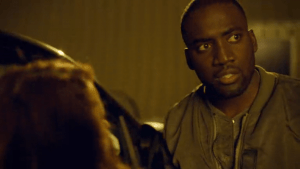
The night scene is cast in yellow to add realistic context to the scene.
The scene following Wynonna’s entrance into the convent is also an excellent example of color usage. So far, everyone in the convent has been wearing white, but here Wynonna wears black. This color choice is simple, but it reinforces the fact that Wynonna does not belong and that she is there to kill Lou. This black color for Wynonna is a constant motif through the show and often serves to emphasize her rebellious attitude. Overall, although its color choices are basic Wynonna Earp uses them effectively to convey meaning or add context to a scene.
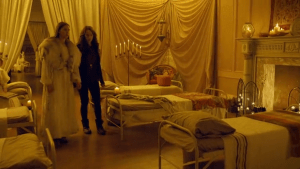
Wynonna is shown in black to separate her from the rest of the women at the convent

